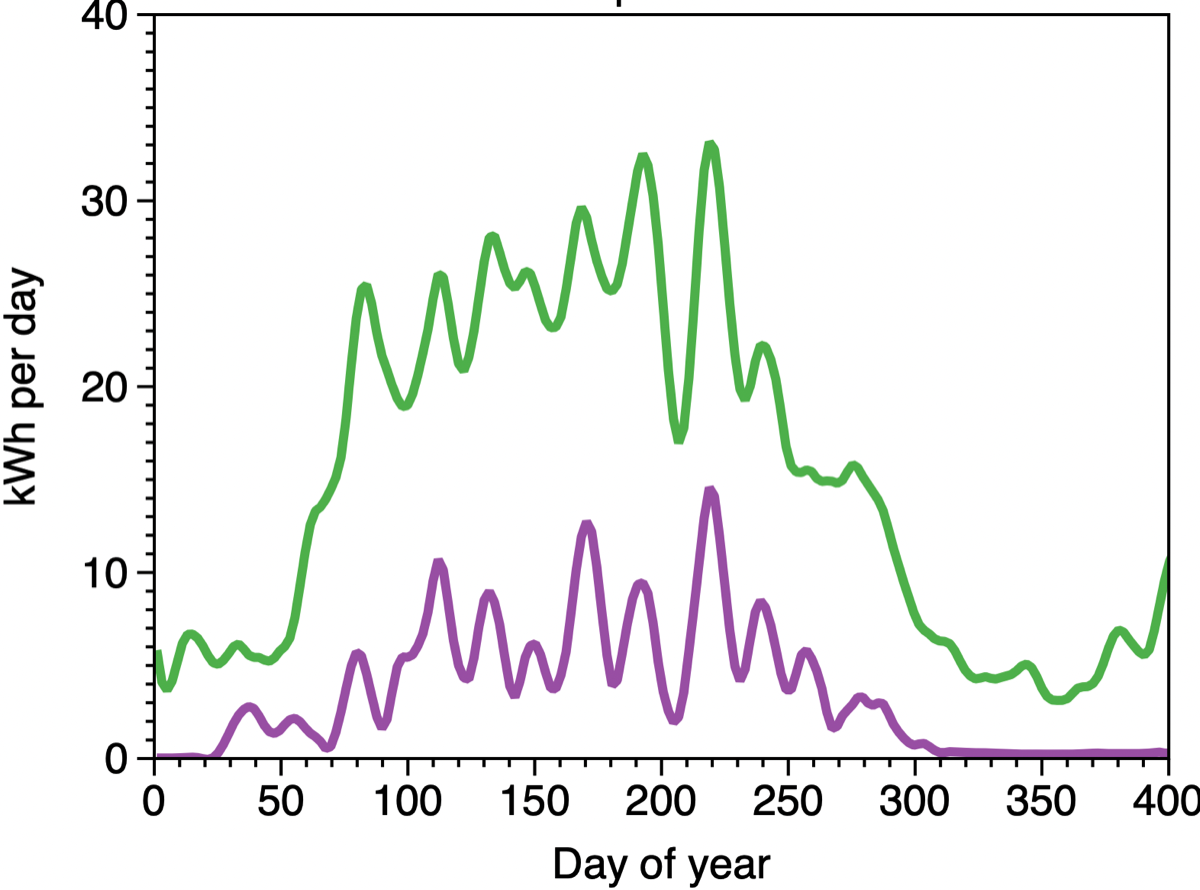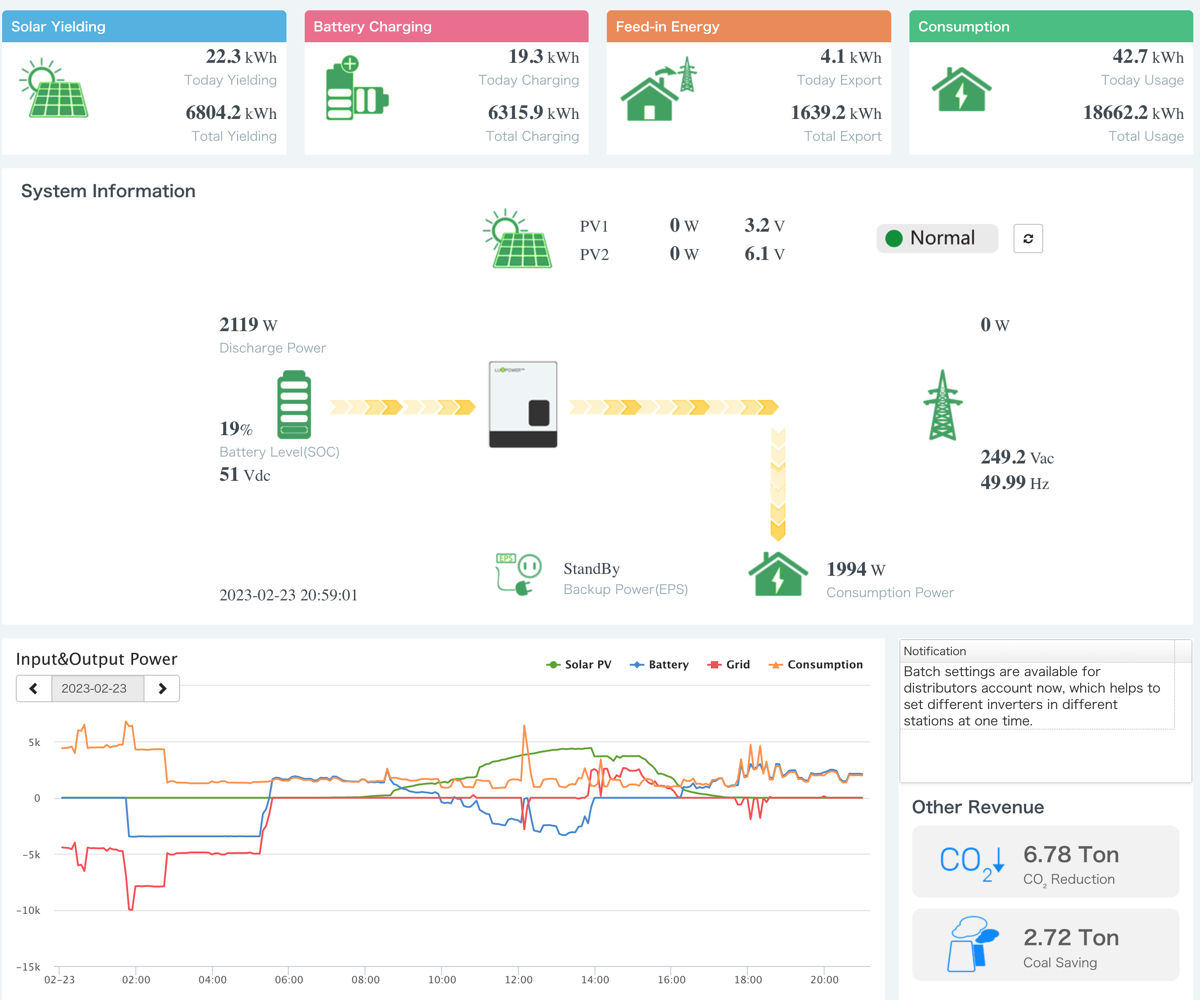The design
In 2018 we moved to a new home. This was blessed with a large, uninterrupted 40 degree pitched roof facing due south. Perfect for solar generation. After deliberation, and a recommendation through Twitter, we went with a company called Contact Solar.
After some discussion and a survey, we settled on a system based on 18 panels, each rated at 385W. Ten of these are facing South, and eight are facing due West.
The panels are connected to a 3.6 kW inverter, which converts panel generated DC into 250V AC for home use or export. In addition, we installed five batteries, each at 2.4 kWh storage, giving us 12 kWh nominal, but maybe 11 kWh useable, since the batteries should not fully discharge.
The installation
Happened at the end of September 2021. The time when the sun was dipping lower and days were getting shorter.
The installation had teething problems, but communications were good, and all issues were fixed (I am sanguine about hiccups, they happen, not worth wasting heartbeats over.
There was a continued issue with the current clamp that was giving erronous readings - this did not affect the performance at all, but made the data look silly (100 kWh consumption per day!). However, this too was fixed by CS, and the system is now very settled.
The company is very good, and they answer the phone and give real help and advice. I suspect they are growing, and I hope they also scale their level of customer support. I'd recommend them not on the technology, although this is fine, but because of their customer service.
In 2018 we moved to a new home. This was blessed with a large, uninterrupted 40 degree pitched roof facing due south. Perfect for solar generation. After deliberation, and a recommendation through Twitter, we went with a company called Contact Solar.
After some discussion and a survey, we settled on a system based on 18 panels, each rated at 385W. Ten of these are facing South, and eight are facing due West.
The panels are connected to a 3.6 kW inverter, which converts panel generated DC into 250V AC for home use or export. In addition, we installed five batteries, each at 2.4 kWh storage, giving us 12 kWh nominal, but maybe 11 kWh useable, since the batteries should not fully discharge.
The installation
Happened at the end of September 2021. The time when the sun was dipping lower and days were getting shorter.
The installation had teething problems, but communications were good, and all issues were fixed (I am sanguine about hiccups, they happen, not worth wasting heartbeats over.
There was a continued issue with the current clamp that was giving erronous readings - this did not affect the performance at all, but made the data look silly (100 kWh consumption per day!). However, this too was fixed by CS, and the system is now very settled.
The company is very good, and they answer the phone and give real help and advice. I suspect they are growing, and I hope they also scale their level of customer support. I'd recommend them not on the technology, although this is fine, but because of their customer service.
A system for nerds
I really like the information you can gain, either from the app or the web access, and with a degree of effort, and a degree in nerdiness, it is possible to build a clear picture of performance and optimisation.
Our electricity supplier (Octopus, brilliant) has tariffs with off peak periods at very low rates, including tariffs for BEV charging (11:30 pm to 5:30am). We also use this period for other power hungry requirements.
For example, we fill the battery overnight at these cheap rates, ameliorating grid demand in the mornings. but in summer, this is needed less, as there is plenty of power still in the solar-filled battery for the overnight usage.
By 8am in summer, we're usually generating more than we use, so the remainder is going into the battery or to export.
You can set the time of battery top up, duration, and degree of charging you need. Lots of things to play with, but does need an understanding of the system.
It is easy to export the data into a decent graphing package - see the small graph below - green solar generation in kWh per day, and purple, exported to grid.
I really like the information you can gain, either from the app or the web access, and with a degree of effort, and a degree in nerdiness, it is possible to build a clear picture of performance and optimisation.
Our electricity supplier (Octopus, brilliant) has tariffs with off peak periods at very low rates, including tariffs for BEV charging (11:30 pm to 5:30am). We also use this period for other power hungry requirements.
For example, we fill the battery overnight at these cheap rates, ameliorating grid demand in the mornings. but in summer, this is needed less, as there is plenty of power still in the solar-filled battery for the overnight usage.
By 8am in summer, we're usually generating more than we use, so the remainder is going into the battery or to export.
You can set the time of battery top up, duration, and degree of charging you need. Lots of things to play with, but does need an understanding of the system.
It is easy to export the data into a decent graphing package - see the small graph below - green solar generation in kWh per day, and purple, exported to grid.

Some statistics
In the proposal from Contact Solar, they predicted an annual generation of just over 5 MWh (or 5000 kWh).
In fact we realised 5.84 MW in 2022, 117% of prediction, which was a nice outcome.
This year, so far (mid Feb 23) we have generated 391 kWh, compared to 275 kWh in the same period last year. So the system continues to do well.
From the screenshot below, we have, since installation, generated 6.8 MWh of electricity, or which we exported 1.64 MWh to the grid.
You can also se that we have reduced our CO2 production by 6.6 tonnes!
In terms of exporting electricity, it is is the worst option, because the export rates are so poor - and have not increased at all recently. Everything becomes about managing surplus power during the day.
In the proposal from Contact Solar, they predicted an annual generation of just over 5 MWh (or 5000 kWh).
In fact we realised 5.84 MW in 2022, 117% of prediction, which was a nice outcome.
This year, so far (mid Feb 23) we have generated 391 kWh, compared to 275 kWh in the same period last year. So the system continues to do well.
From the screenshot below, we have, since installation, generated 6.8 MWh of electricity, or which we exported 1.64 MWh to the grid.
You can also se that we have reduced our CO2 production by 6.6 tonnes!
In terms of exporting electricity, it is is the worst option, because the export rates are so poor - and have not increased at all recently. Everything becomes about managing surplus power during the day.
